Blog
Possible Symptoms of Athlete’s Foot
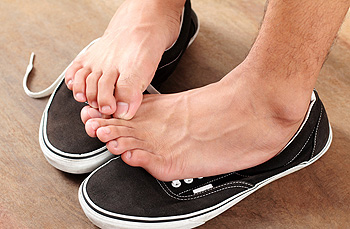 The medical condition that is known as athlete’s foot often affects the top layer of skin on the foot. It lives and thrives in warm and moist environments, which can include shower room floors, public pools, or locker rooms, and surrounding areas. Many patients experience symptoms that typically consist of severe itching between the toes, and flaking skin on the bottom of the feet. Additionally, there may be a tingling or burning sensation that is felt on different parts of the feet. Athlete’s foot is considered to be contagious, and may be transmitted to another person in contaminated clothing, socks, or shoes. For mild cases of this ailment, mild relief may be found by applying an anti-fungal powder or cream. If you feel you have developed athlete’s foot, it is suggested that you consult with a podiatrist who can guide you toward the best treatment for you.
The medical condition that is known as athlete’s foot often affects the top layer of skin on the foot. It lives and thrives in warm and moist environments, which can include shower room floors, public pools, or locker rooms, and surrounding areas. Many patients experience symptoms that typically consist of severe itching between the toes, and flaking skin on the bottom of the feet. Additionally, there may be a tingling or burning sensation that is felt on different parts of the feet. Athlete’s foot is considered to be contagious, and may be transmitted to another person in contaminated clothing, socks, or shoes. For mild cases of this ailment, mild relief may be found by applying an anti-fungal powder or cream. If you feel you have developed athlete’s foot, it is suggested that you consult with a podiatrist who can guide you toward the best treatment for you.
Athlete’s foot is an inconvenient condition that can be easily reduced with the proper treatment. If you have any concerns about your feet and ankles, contact Shaun J. Limon, DPM and Lisa Griffith-Limon, DPM from Limons Foot & Ankle Care. Our doctors will treat your foot and ankle needs.
Athlete’s Foot: The Sole Story
Athlete's foot, also known as tinea pedis, can be an extremely contagious foot infection. It is commonly contracted in public changing areas and bathrooms, dormitory style living quarters, around locker rooms and public swimming pools, or anywhere your feet often come into contact with other people.
Solutions to Combat Athlete’s Foot
- Hydrate your feet by using lotion
- Exfoliate
- Buff off nails
- Use of anti-fungal products
- Examine your feet and visit your doctor if any suspicious blisters or cuts develop
Athlete’s foot can cause many irritating symptoms such as dry and flaking skin, itching, and redness. Some more severe symptoms can include bleeding and cracked skin, intense itching and burning, and even pain when walking. In the worst cases, Athlete’s foot can cause blistering as well. Speak to your podiatrist for a better understanding of the different causes of Athlete’s foot, as well as help in determining which treatment options are best for you.
If you have any questions please feel free to contact our offices located in Bradenton and Lakewood Ranch, FL . We offer the newest diagnostic and treatment technologies for all your foot and ankle needs.
Read more about Athlete’s FootHeel Pain Can Be Treated!
Gout Attacks May Be Painful
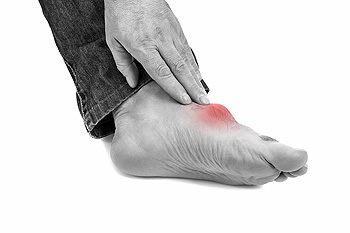 The medical condition that is known as gout can be uncomfortable. This form of arthritis generally causes severe pain and discomfort in the big toe and surrounding areas. The pain comes from the joints, and is caused by elevated uric acid levels in the blood. Many patients who experience gout attacks equate the pain to needle-like sensations, and it may be painful if anything touches the toe. Symptoms of this condition often include redness and swelling around the affected joints. Research has indicated that this ailment can develop from genetic traits, or from certain foods that are eaten. These can include red meat, shellfish, and drinks that have large amounts of sugar in them. A proper diagnosis can consist of having a blood test performed which may be helpful in determining the amount of uric acid that is present. Additionally, it may be beneficial to use a needle to remove a portion of the crystals from the painful joints. If you have been afflicted with gout attacks, it is suggested that you speak to a podiatrist who can properly treat this condition.
The medical condition that is known as gout can be uncomfortable. This form of arthritis generally causes severe pain and discomfort in the big toe and surrounding areas. The pain comes from the joints, and is caused by elevated uric acid levels in the blood. Many patients who experience gout attacks equate the pain to needle-like sensations, and it may be painful if anything touches the toe. Symptoms of this condition often include redness and swelling around the affected joints. Research has indicated that this ailment can develop from genetic traits, or from certain foods that are eaten. These can include red meat, shellfish, and drinks that have large amounts of sugar in them. A proper diagnosis can consist of having a blood test performed which may be helpful in determining the amount of uric acid that is present. Additionally, it may be beneficial to use a needle to remove a portion of the crystals from the painful joints. If you have been afflicted with gout attacks, it is suggested that you speak to a podiatrist who can properly treat this condition.
Gout is a foot condition that requires certain treatment and care. If you are seeking treatment, contact Shaun J. Limon, DPM and Lisa Griffith-Limon, DPM from Limons Foot & Ankle Care. Our doctors will treat your foot and ankle needs.
What Is Gout?
Gout is a type of arthritis caused by a buildup of uric acid in the bloodstream. It often develops in the foot, especially the big toe area, although it can manifest in other parts of the body as well. Gout can make walking and standing very painful and is especially common in diabetics and the obese.
People typically get gout because of a poor diet. Genetic predisposition is also a factor. The children of parents who have had gout frequently have a chance of developing it themselves.
Gout can easily be identified by redness and inflammation of the big toe and the surrounding areas of the foot. Other symptoms include extreme fatigue, joint pain, and running high fevers. Sometimes corticosteroid drugs can be prescribed to treat gout, but the best way to combat this disease is to get more exercise and eat a better diet.
If you have any questions please feel free to contact our offices located in Bradenton and Lakewood Ranch, FL . We offer the newest diagnostic and treatment technologies for all your foot and ankle needs.
Read more about Everything You Need to Know About GoutThe Importance of Podiatric Care for Diabetic Patients
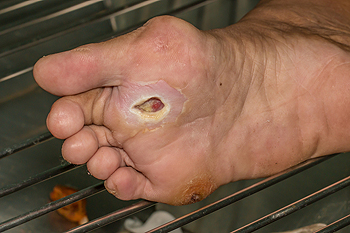 Elevated blood sugar levels may cause foot conditions in diabetic patients. A loss of feeling may develop in the feet, which is referred to as neuropathy, and this can make it difficult to feel any sores or cuts that may be on the feet. An open sore may become infected, and develop into a foot ulcer. If this is left untreated, it may lead to amputation. There are several symptoms that can indicate serious foot conditions in diabetic patients. These can include a tingling sensation, staining on the socks, and the feet may feel cold. It is strongly advised that patients who are afflicted with diabetes are under the routine care of a podiatrist who can help them to efficiently manage this condition.
Elevated blood sugar levels may cause foot conditions in diabetic patients. A loss of feeling may develop in the feet, which is referred to as neuropathy, and this can make it difficult to feel any sores or cuts that may be on the feet. An open sore may become infected, and develop into a foot ulcer. If this is left untreated, it may lead to amputation. There are several symptoms that can indicate serious foot conditions in diabetic patients. These can include a tingling sensation, staining on the socks, and the feet may feel cold. It is strongly advised that patients who are afflicted with diabetes are under the routine care of a podiatrist who can help them to efficiently manage this condition.
Diabetic foot care is important in preventing foot ailments such as ulcers. If you are suffering from diabetes or have any other concerns about your feet, contact Shaun J. Limon, DPM and Lisa Griffith-Limon, DPM from Limons Foot & Ankle Care. Our doctors can provide the care you need to keep you pain-free and on your feet.
Diabetic Foot Care
Diabetes affects millions of people every year. The condition can damage blood vessels in many parts of the body, especially the feet. Because of this, taking care of your feet is essential if you have diabetes, and having a podiatrist help monitor your foot health is highly recommended.
The Importance of Caring for Your Feet
- Routinely inspect your feet for bruises or sores.
- Wear socks that fit your feet comfortably.
- Wear comfortable shoes that provide adequate support.
Patients with diabetes should have their doctor monitor their blood levels, as blood sugar levels play such a huge role in diabetic care. Monitoring these levels on a regular basis is highly advised.
It is always best to inform your healthcare professional of any concerns you may have regarding your feet, especially for diabetic patients. Early treatment and routine foot examinations are keys to maintaining proper health, especially because severe complications can arise if proper treatment is not applied.
If you have any questions please feel free to contact our offices located in Bradenton and Lakewood Ranch, FL . We offer the newest diagnostic and treatment technologies for all your foot and ankle needs.
Read more about How to Care for Diabetic FootReminder: When Was the Last Time...?
Symptoms of Toenail Fungus
 One of the first signs patients notice if they may have a toenail fungus are yellowed and brittle nails. Additional symptoms can include toenails that lift away from the nail bed, uneven toenail growth, and with severe infections, there may be a foul odor. Research has shown the fungus which generally causes this condition lives and thrives in warm and moist environments. It is suggested to wear appropriate shoes while in these areas, which can include public swimming pools, shower room floors, and surrounding areas. It may be beneficial to use an antifungal spray or powder after thoroughly washing and drying your feet. It is advised that you speak to a podiatrist if you have developed toenail fungus, who can offer the best course of treatment for you.
One of the first signs patients notice if they may have a toenail fungus are yellowed and brittle nails. Additional symptoms can include toenails that lift away from the nail bed, uneven toenail growth, and with severe infections, there may be a foul odor. Research has shown the fungus which generally causes this condition lives and thrives in warm and moist environments. It is suggested to wear appropriate shoes while in these areas, which can include public swimming pools, shower room floors, and surrounding areas. It may be beneficial to use an antifungal spray or powder after thoroughly washing and drying your feet. It is advised that you speak to a podiatrist if you have developed toenail fungus, who can offer the best course of treatment for you.
For more information about treatment, contact Shaun J. Limon, DPM and Lisa Griffith-Limon, DPM of Limons Foot & Ankle Care. Our doctors can provide the care you need to keep you pain-free and on your feet.
Toenail Fungus Treatment
Toenail fungus is a condition that affects many people and can be especially hard to get rid of. Fortunately, there are several methods to go about treating and avoiding it.
Antifungals & Deterrence
Oral antifungal medicine has been shown to be effective in many cases. It is important to consult with a podiatrist to determine the proper regiment for you, or potentially explore other options.
Applying foot powder on the feet and shoes helps keep the feet free of moisture and sweat.
Sandals or open toed shoes – Wearing these will allow air movement and help keep feet dry. They also expose your feet to light, which fungus cannot tolerate. Socks with moisture wicking material also help as well.
If you have any questions please feel free to contact our offices located in Bradenton and Lakewood Ranch, FL . We offer the newest diagnostic tools and technology to treat your foot and ankle needs.
Read more about Toenail FungusHow Do Stress Fractures Develop?
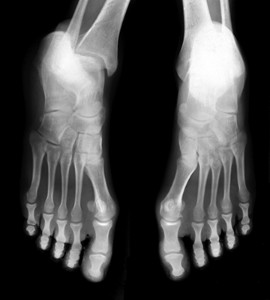 Stress fractures are characterized as tiny cracks in the bone. They are typically painful and often develop overtime. They are typically caused by overuse, or a repetitive application of force. Athletes are generally affected by this condition because they frequently participate in weight bearing activities like running or jumping. Those who suddenly increase the difficulty level of a weight bearing activity increase their risk of getting a stress fracture, especially if the body is not properly trained or warmed up. Stress fractures can be a debilitating condition if left untreated and require professional care. For more information on stress fractures, we recommend you consult with a podiatrist for a proper diagnosis and an advised treatment plan.
Stress fractures are characterized as tiny cracks in the bone. They are typically painful and often develop overtime. They are typically caused by overuse, or a repetitive application of force. Athletes are generally affected by this condition because they frequently participate in weight bearing activities like running or jumping. Those who suddenly increase the difficulty level of a weight bearing activity increase their risk of getting a stress fracture, especially if the body is not properly trained or warmed up. Stress fractures can be a debilitating condition if left untreated and require professional care. For more information on stress fractures, we recommend you consult with a podiatrist for a proper diagnosis and an advised treatment plan.
Stress fractures occur when there is a tiny crack within a bone. To learn more, contact Shaun J. Limon, DPM and Lisa Griffith-Limon, DPM from Limons Foot & Ankle Care. Our doctors can provide the care you need to keep you pain free and on your feet.
How Are They Caused?
Stress fractures are the result of repetitive force being placed on the bone. Since the lower leg and feet often carry most of the body’s weight, stress fractures are likely to occur in these areas. If you rush into a new exercise, you are more likely to develop a stress fracture since you are starting too much, too soon. Pain resulting from stress fractures may go unnoticed at first, however it may start to worsen over time.
Risk Factors
- Gender – They are more commonly found in women compared to men.
- Foot Problems – People with unusual arches in their feet are more likely to develop stress fractures.
- Certain Sports – Dancers, gymnasts, tennis players, runners, and basketball players are more likely to develop stress fractures.
- Lack of Nutrients – A lack of vitamin D and calcium may weaken the bones and make you more prone to stress fractures
- Weak Bones – Osteoporosis can weaken the bones therefore resulting in stress fractures
Stress fractures do not always heal properly, so it is important that you seek help from a podiatrist if you suspect you may have one. Ignoring your stress fracture may cause it to worsen, and you may develop chronic pain as well as additional fractures.
If you have any questions, please feel free to contact our office located in Lakewood Ranch, FL . We offer the newest diagnostic and treatment technologies for all your foot care needs.
Why Live with Pain and Numbness in Your Feet?
The Importance of Stretching Your Feet
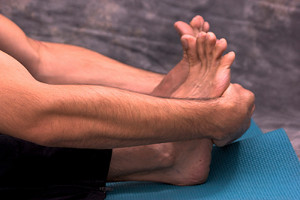 Because the feet are the foundation of the body, and carry your weight on a day to day basis, it is important to make sure you are keeping the muscles strong. To help maintain a healthy, strong foot structure, it is recommended that you perform foot stretches. One simple exercise you can practice consists of sitting on the floor with your legs stretched out and wrapping a towel around the balls of your feet. Once comfortable, begin pulling your toes towards your body while keeping your knees straight, and repeating this motion 3 times for each foot, while holding for 30 seconds. Another exercise you can practice to build strength involves sitting in a chair, and with your heel on the ground, picking up a towel with your toes. Adding these simple exercises to your daily routine can help benefit the overall health of your feet. If you would like more ideas on how to stretch the feet, we suggest you speak with a podiatrist for professional tips and recommendations.
Because the feet are the foundation of the body, and carry your weight on a day to day basis, it is important to make sure you are keeping the muscles strong. To help maintain a healthy, strong foot structure, it is recommended that you perform foot stretches. One simple exercise you can practice consists of sitting on the floor with your legs stretched out and wrapping a towel around the balls of your feet. Once comfortable, begin pulling your toes towards your body while keeping your knees straight, and repeating this motion 3 times for each foot, while holding for 30 seconds. Another exercise you can practice to build strength involves sitting in a chair, and with your heel on the ground, picking up a towel with your toes. Adding these simple exercises to your daily routine can help benefit the overall health of your feet. If you would like more ideas on how to stretch the feet, we suggest you speak with a podiatrist for professional tips and recommendations.
Stretching the feet is a great way to prevent injuries. If you have any concerns with your feet consult with Shaun J. Limon, DPM and Lisa Griffith-Limon, DPM from Limons Foot & Ankle Care. Our doctors will assess your condition and provide you with quality foot and ankle treatment.
Stretching the Feet
Being the backbone of the body, the feet carry your entire weight and can easily become overexerted, causing cramps and pain. As with any body part, stretching your feet can serve many benefits. From increasing flexibility to even providing some pain relief, be sure to give your feet a stretch from time to time. This is especially important for athletes or anyone performing aerobic exercises, but anyone experiencing foot pain or is on their feet constantly should also engage in this practice.
Great ways to stretch your feet:
- Crossing one leg over the others and carefully pull your toes back. Do 10-20 repetitions and repeat the process for each foot
- Face a wall with your arms out and hands flat against the wall. Step back with one foot and keep it flat on the floor while moving the other leg forward. Lean towards the wall until you feel a stretch. Hold for 30 seconds and perform 10 repetitions for each foot
- Be sure not to overextend or push your limbs too hard or you could risk pulling or straining your muscle
Individuals who tend to their feet by regular stretching every day should be able to minimize foot pain and prevent new problems from arising.
If you have any questions, please feel free to contact our offices located in Bradenton and Lakewood Ranch, FL . We offer the newest diagnostic and treatment technologies for all your foot care needs.
Read more about Stretching Your FeetHow to Handle Poor Foot Circulation
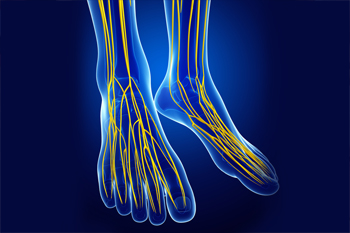 Those who are living with diabetes may be more likely to experience poor circulation in their feet. Poor circulation can lead to a number of foot complications including neuropathy and peripheral artery disease. There are, however, a few things you can do to better prevent poor circulation. Resisting smoking is a good way to reduce your likelihood of having poor circulation, since smoking makes arteries harden faster. Maintaining healthy blood pressure and cholesterol levels may also assist in reducing poor circulation. It is additionally recommended to practice an exercise routine, as exercise helps to stimulate blood flow. Because poor circulation can lead to more severe foot complications, it is recommended that you consult with a podiatrist for a proper diagnosis and advice on treatment options.
Those who are living with diabetes may be more likely to experience poor circulation in their feet. Poor circulation can lead to a number of foot complications including neuropathy and peripheral artery disease. There are, however, a few things you can do to better prevent poor circulation. Resisting smoking is a good way to reduce your likelihood of having poor circulation, since smoking makes arteries harden faster. Maintaining healthy blood pressure and cholesterol levels may also assist in reducing poor circulation. It is additionally recommended to practice an exercise routine, as exercise helps to stimulate blood flow. Because poor circulation can lead to more severe foot complications, it is recommended that you consult with a podiatrist for a proper diagnosis and advice on treatment options.
While poor circulation itself isn’t a condition; it is a symptom of another underlying health condition you may have. If you have any concerns with poor circulation in your feet contact Shaun J. Limon, DPM and Lisa Griffith-Limon, DPM of Limons Foot & Ankle Care. Our doctors will treat your foot and ankle needs.
Poor Circulation in the Feet
Peripheral artery disease (PAD) can potentially lead to poor circulation in the lower extremities. PAD is a condition that causes the blood vessels and arteries to narrow. In a linked condition called atherosclerosis, the arteries stiffen up due to a buildup of plaque in the arteries and blood vessels. These two conditions can cause a decrease in the amount of blood that flows to your extremities, therefore resulting in pain.
Symptoms
Some of the most common symptoms of poor circulation are:
- Numbness
- Tingling
- Throbbing or stinging pain in limbs
- Pain
- Muscle Cramps
Treatment for poor circulation often depends on the underlying condition that causes it. Methods for treatment may include insulin for diabetes, special exercise programs, surgery for varicose veins, or compression socks for swollen legs.
As always, see a podiatrist as he or she will assist in finding a regimen that suits you. A podiatrist can also prescribe you any needed medication.
If you have any questions, please feel free to contact our offices located in Bradenton and Lakewood Ranch, FL . We offer the newest diagnostic and treatment technologies for all your foot care needs.
Read more about Causes Symptoms and Treatment for Poor Circulation in the FeetMore...
Plantar Warts Can Be Treated!
Can Flat Feet Cause Pain?
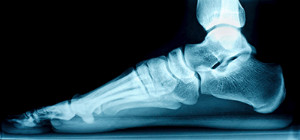 The medical term that is known as flat feet refers to feet that have an absent or low arch. The majority of babies are born without an arch, however it will generally develop as they enter their teenage years. This condition is noticeable when the foot lies completely on the floor. The foot will naturally turn inward in order to grip the floor, which may cause pain and discomfort. The Achilles tendon may become affected as a result of the position of the heel, and this may lead to difficulty with walking. Many patients have found relief when orthotics are worn, which may provide the support that is needed as daily tasks are completed. If you have flat feet, it is suggested that you consult with a podiatrist who can properly evaluate your condition, and recommend the best treatment option for you.
The medical term that is known as flat feet refers to feet that have an absent or low arch. The majority of babies are born without an arch, however it will generally develop as they enter their teenage years. This condition is noticeable when the foot lies completely on the floor. The foot will naturally turn inward in order to grip the floor, which may cause pain and discomfort. The Achilles tendon may become affected as a result of the position of the heel, and this may lead to difficulty with walking. Many patients have found relief when orthotics are worn, which may provide the support that is needed as daily tasks are completed. If you have flat feet, it is suggested that you consult with a podiatrist who can properly evaluate your condition, and recommend the best treatment option for you.
Flatfoot is a condition many people suffer from. If you have flat feet, contact Shaun J. Limon, DPM and Lisa Griffith-Limon, DPM from Limons Foot & Ankle Care. Our doctors will treat your foot and ankle needs.
What Are Flat Feet?
Flatfoot is a condition in which the arch of the foot is depressed and the sole of the foot is almost completely in contact with the ground. About 20-30% of the population generally has flat feet because their arches never formed during growth.
Conditions & Problems:
Having flat feet makes it difficult to run or walk because of the stress placed on the ankles.
Alignment – The general alignment of your legs can be disrupted, because the ankles move inward which can cause major discomfort.
Knees – If you have complications with your knees, flat feet can be a contributor to arthritis in that area.
Symptoms
- Pain around the heel or arch area
- Trouble standing on the tip toe
- Swelling around the inside of the ankle
- Flat look to one or both feet
- Having your shoes feel uneven when worn
Treatment
If you are experiencing pain and stress on the foot you may weaken the posterior tibial tendon, which runs around the inside of the ankle.
If you have any questions please feel free to contact our offices located in Bradenton and Lakewood Ranch, FL . We offer the newest diagnostic and treatment technologies for all your foot and ankle needs.
Read more about Flat FeetPossible Causes of an Ingrown Toenail
 The condition that is known as an ingrown toenail typically affects the big toe. It occurs as a result of the outer edges of the toenail growing into the skin. Patients who are afflicted with this ailment are often familiar with the pain and discomfort an ingrown toenail may cause. If the toenail is infected, there can be drainage oozing from the surrounding area. General reasons why ingrown toenails may develop can include trimming the nails incorrectly, or wearing shoes that do not have ample room for the toes to move freely in. Participating in certain sporting activities where trauma is placed on the toe may contribute to the formation of an ingrown toenail. If you have this condition, it is suggested that you consult with a podiatrist as quickly as possible who can guide you toward proper treatment techniques.
The condition that is known as an ingrown toenail typically affects the big toe. It occurs as a result of the outer edges of the toenail growing into the skin. Patients who are afflicted with this ailment are often familiar with the pain and discomfort an ingrown toenail may cause. If the toenail is infected, there can be drainage oozing from the surrounding area. General reasons why ingrown toenails may develop can include trimming the nails incorrectly, or wearing shoes that do not have ample room for the toes to move freely in. Participating in certain sporting activities where trauma is placed on the toe may contribute to the formation of an ingrown toenail. If you have this condition, it is suggested that you consult with a podiatrist as quickly as possible who can guide you toward proper treatment techniques.
Ingrown toenails can become painful if they are not treated properly. For more information about ingrown toenails, contact Shaun J. Limon, DPM and Lisa Griffith-Limon, DPM of Limons Foot & Ankle Care. Our doctors can provide the care you need to keep you pain-free and on your feet.
Ingrown Toenails
Ingrown toenails occur when a toenail grows sideways into the bed of the nail, causing pain, swelling, and possibly infection.
Causes
- Bacterial infections
- Improper nail cutting such as cutting it too short or not straight across
- Trauma to the toe, such as stubbing, which causes the nail to grow back irregularly
- Ill-fitting shoes that bunch the toes too close together
- Genetic predisposition
Prevention
Because ingrown toenails are not something found outside of shoe-wearing cultures, going barefoot as often as possible will decrease the likeliness of developing ingrown toenails. Wearing proper fitting shoes and using proper cutting techniques will also help decrease your risk of developing ingrown toenails.
Treatment
Ingrown toenails are a very treatable foot condition. In minor cases, soaking the affected area in salt or antibacterial soaps will not only help with the ingrown nail itself, but also help prevent any infections from occurring. In more severe cases, surgery is an option. In either case, speaking to your podiatrist about this condition will help you get a better understanding of specific treatment options that are right for you.
If you have any questions please feel free to contact our offices located in Bradenton and Lakewood Ranch, FL . We offer the newest diagnostic and treatment technologies for all your foot and ankle needs.
Read more about Ingrown Toenail Care




